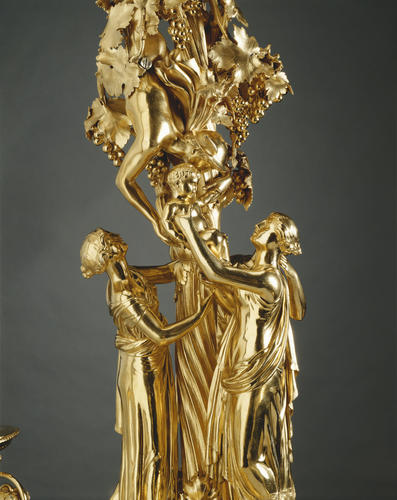Mercury and Bacchus candelabrum (part of The Grand Service) 1809-17
Silver gilt | 125 x 66 x 66 cm (whole object) | RCIN 51977
-
A large silver-gilt six-light candelabrum cast and chased as a fruiting vinestock with Mercury among the branches passing the infant Bacchus to three nymphs. The branches are entwined and cast with foliage and birds; the lower section is fitted with a further six branches, cast with acanthus and lotus leaves, around a central stem where three seated figures sit playing musical instruments, on a triangular base with incurved sides, and paired lion paw and acanthus feet.
This candelabrum and its pair (telling the story of the Apples of the Hesperides) were the largest and most magnificent candelabra in George IV's splendid Grand Service of banqueting plate. The sculptural group around the stem depicts part of the legend of Bacchus, after his birth from the thigh of Jupiter. Mercury had sewn him into Jupiter's thigh after his mother Semele had been consumed by a thunderbolt during her pregnancy.
The stems and the upper branches were added by Rundells in 1816/7 to a pair of smaller centrepieces also made by Paul Storr (for Rundells) about seven years earlier. The base and lower branches, described as 'a very large and superb Ornament for the Centre of the Table', were supplied by Rundells to George IV and invoiced in June 1811 for the huge sum of £2,017 16s. The figures of piping fauns and panthers were almost certainly modelled by the sculptor William Theed and show a surprising naturalism which anticipates silver of the Victorian period. The centre was originally occupied with '3 dancing nymphs' and a basket for flowers.
The enrichment of the candelabrum in 1816/7, involving the stems and everything above the level of the lower candle branches was made at a total cost of £1,365. The invoice describes '2 elegant richly chased Candelabra to fit occasionally the gilt Tripod Stands with the piping Fauns, composed from designs made by FLAXMAN on the subject of Mercury presenting Bacchus to the Nymphs, the other the Serpent guarding the Tree of Hesperides with elegant falling Branches and Ornamental devices'.
John Flaxman began designing plate for Rundells around 1805 and continued until his death over twenty years later. Designs for the Mercury and Bacchus stem survive in the British Museum and the V&A Museum. Because Flaxman was rarely concerned with functional components the candle branches are omitted from the design; his figure groups would have been modelled by either William Theed or Edward Hodges Baily, a former pupil of Flaxman who joined Rundells in 1815. Rundells' artists made use of both Renaissance and classical sources. the form of the candelabra recalls the richly sculptural bronze tripods made in Venice during the sixteenth century. Likewise the piping fauns at the angles resemble bronze statuettes such as the Pan listening to Echo traditionally attributed to Riccio, in the Ashmolean Museum, Oxford.
Text adapted from Royal Treasures, A Golden Jubilee Celebration, London, 2002Provenance
Base and lower branches purchased by George IV when Prince of Wales from Rundell, Bridge & Rundell, invoiced 4 June 1811 (£1,985 19s); stem and upper branches added by Rundells 1816-17, for £1,365.
-
Creator(s)
(goldsmith)(designer)(modeller)(retailer/supplier)Acquirer(s)
-
Medium and techniques
Silver gilt
Measurements
125 x 66 x 66 cm (whole object)










